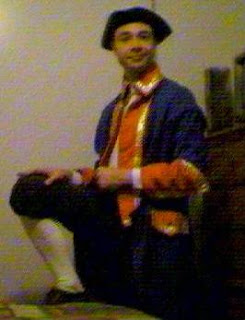
STARTED: August 2015
COMPLETED: November 2015 (mostly, except for a few buttons)
DEGREE OF DIFFICULTY: Medium to advanced.
THE IDEA: I love the look of mid-1700's coats. They're full and skirty and can be very foppy. If you got it, flaunt it. Next to the puffy breeches, this would be my biggest and most complex project yet. I also wanted a more comfortable red coat because the fancy privateer one I have crimps my shoulders.
THE CHALLENGES: I used a J.P. Ryan pattern with red muslin and white muslin lining bought on the cheap from SAS. Not only would this limit the damages if I blew the project, I would also have a thinner coat designed for the ravages of Arizona heat.
Cutting this pattern required considerably more space than my dining room table would afford. I ended up spreading the fabric and the pattern on the floor to trace before cutting.
The instructions strongly recommend pinning together a mock-up from the lining pieces to test the fit, which I did. No problems whatsoever.
Sewing the pockets into the coat front required carefully lining up several pieces on the dot and cutting carefully. The pockets are both strong and functional.
I made the mistake -- again -- of making two left sleeves. With the help of my sewing mentor, not only were we able to correct this gracefully, we were also able to attach the cuffs without having to do a hand stitch. I also lowered the seam allowance from 5/8" to about 1/4" to give my arms some extra room, especially when they're encased in a puffy shirt.
I got hints from another 1740's coat I purchased earlier this year. Sometimes it's easier for me to look at a finished garment and reverse-engineer it in my head rather than stew over instructions for half an hour and end up grabbing the seam ripper. This helped me figure out how the back pleats on the skirted part should look.
Buttonholes on the front proved too long for my automatic buttonhole attachment. I had to fake the stitch around the holes by manually flicking the mechanism on my machine when I got to the desired length. The end result is not exactly beautiful in a couple of places, but at least the seam is holding (for now). Note to self: make shorter buttonholes.
The buttons came from another visit to SAS. Unfortunately, they were too big to fit the holes for the pockets. I'm now searching for smaller pocket buttons which will compliment the large front ones.
THE RESULT: Call it "Big Red." It's a beautiful red coat, although it's not a Redcoat's red coat. Not only is it fun to wear, it's fun to dance in. The skirtiness covers up a lot of my kilt, but breeches should fare better. The swish of the skirt should draw a lady's eye to my shapely stockinged calves, which is where I want them looking!
 I'm not done yet. On the left you see the material I've picked out for another weskit. Again, it's satin jacquard to complement the coat on the right, but I'm hoping it doesn't overpower the look. On the other hand, a weskit I have with my 1700's blue satin jacket has intricately embroidered roses that catch many an eye. People always ask about it. That could count as overpowering.
I'm not done yet. On the left you see the material I've picked out for another weskit. Again, it's satin jacquard to complement the coat on the right, but I'm hoping it doesn't overpower the look. On the other hand, a weskit I have with my 1700's blue satin jacket has intricately embroidered roses that catch many an eye. People always ask about it. That could count as overpowering.



































